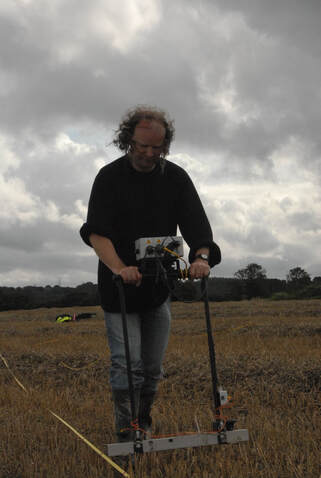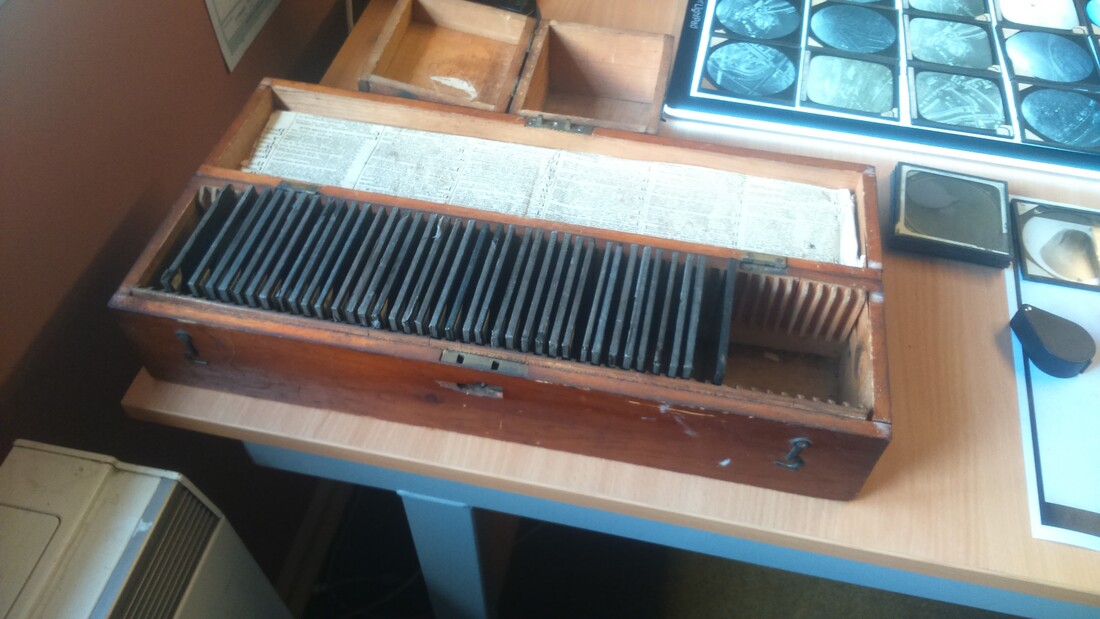|
Martyn is Senior Researcher in the Aerial Investigation and Mapping team, Historic England. Interview with Dr Amara Thornton, IoA History of Archaeology Network Coordinator. AT: How would you define history of archaeology? MB: I’m not sure that I’d want to… I think it’s more important to recognise that every aspect of modern archaeological practice has a history, and that history is more likely than not to be messy, complex, and not confined to the archaeological literature. And, of course, that history isn’t disconnected from the present. AT: What is your area of research in the history of archaeology? MB: The main things currently are (i) the various archives (and other sources) relating to OGS Crawford; (ii) the history and development of aerial archaeology; and (iii) the history of Stonehenge and its landscape. The Venn Diagram would show considerable overlap between these three, and of course, there’s a potentially vast range of topics covered by them. AT: How did you become interested in the history of archaeology? MB: I think this goes back to my undergraduate days at Birmingham, and reading things like Chris Chippindale’s Stonehenge Complete, then still in its first edition (does he regret the title?), alongside Shanks & Tilley’s Re-Constructing Archaeology and Social Theory and Archaeology. More important, though, was one of the bits of coursework we were required to do - detailed survey of the history and archaeology of your home parish, and I realised I quite enjoyed digging in to the lives and times of the various obscure antiquarians and their curious ways. Some weird stuff happened in Westgate-on-Sea. Probably still does. AT: Are you working on anything in particular related to the history of archaeology right now? MB: Always… There are several things ongoing (does mentioning them here commit me to finishing them?). With Crawford, there are many topics vying for attention – at present, I’m primarily interested in the earliest (pre-1920) stages of his archaeological career, especially the influence of Oxford-taught geography and anthropology on his ideas about prehistory. I’m also interested in his unofficial advisory role with Phoenix Press in the 1950s, in which he essentially had power of veto over publication proposals for books on archaeology, anthropology and history. He was paid mainly in cigars. As far as Stonehenge is concerned, I’m mainly interested in various goings-on during the later 19th century, a period that has been misrepresented somewhat in many of the main texts covering the period. I’m also working through the various myths that have emerged over the last 100 years or so (no, the RAF didn’t ask for the stones to be knocked down; no, you couldn’t hire a hammer to chip bits off the stones; etc), which might sound a tad frivolous, but the reasons for their emergence and persistence are closely tied to particular narratives about Stonehenge, especially in relation to questions of ownership and access. With aerial photography, the later 19th century again remains a period of particular interest. Thanks to a stroke of good fortune, some of the earliest surviving aerial photographs taken over England (by Cecil Shadbolt between 1882 and 1890) are now in the Historic England Archive at Swindon, so I hope to be taking a closer look at what he was up to. That’s going to have to wait until I can get to the British Library, among other places, again. AT: What, from your experience, is the most exciting thing you've come across in history of archaeology research and why?
MB: Viewing the Shadbolt collection of photographs (actually his own set of glass lantern slides for use in public lectures) for the first time was particularly memorable. He was a key figure in the early days of photography from balloons, but when I wrote A History of Aerial Photography and Archaeology (publ. 2011) I couldn’t track down any of his photographs, and had only seen two reproduced in print. This collection contained 27, all but one taken over London. They appeared a few years ago at an auction house just down the road from the HE Swindon office, still in Shadbolt’s own wooden slide-box. As an aside, can I encourage everyone to try to stop automatically putting the words ‘hot air’ in front of the word ‘balloon’. Think gas instead. Many of the more memorable things I’ve seen came to my attention because someone else had spotted them first and told me about them. With the Shadbolt slides, it was my (now retired) colleague Ian Leith. Collections like that seldom escaped his attention. It was a similar case with the Society for the Protection of Ancient Buildings’ (SPAB) files on Stonehenge. My colleague Rebecca Lane mentioned these to me when we were working on the Stonehenge Landscape project at English Heritage (now Historic England), which was published as The Stonehenge Landscape (Bowden et al 2015). Rebecca was looking at some of the more interesting buildings in the World Heritage Site, but the SPAB files related specifically to Stonehenge itself, and mainly to the period from c1890-1902. They included correspondence from the likes of Pitt Riversand Philip Webb, and underlined the extent of the Arts & Crafts influence on the third Sir Edmund Antrobus’ custodianship of Stonehenge and on the 1901 ‘restoration’ work, including William Gowland’s excavations. Some of this is discussed in Restoring Stonehenge… As far as I can tell, they hadn’t been cited before – the involvement of architects at Stonehenge has been a bit of a blind spot as far as the archaeological history of the site is concerned. Detmar Blow, the architect who was actually in charge on site in 1901, is seldom if ever mentioned in accounts of Gowland’s work, and while the latter’s report (published in Archaeologia in 1902) is frequently referred to, Blow’s report, also published in 1902, wasn’t cited in an archaeological publication until Bowden et al 2015. AT: Do you have any favourite books (academic or popular) related to the history of archaeology? Titles and authors would be great, and a few thoughts as to why. MB: Adam Stout’s Creating Prehistory and Kitty Hauser’s Shadow Sites (as well as her Crawford biography Bloody Old Britain) are books I’d happily recommend to anyone interested in the history of British archaeology, and particularly prehistory and aerial archaeology, prior to WW2. In fact, everyone should read them, whatever your interests, Another book I’m always surprised that many people don’t know about is Lorraine Daston and Peter Galison’s Objectivity. As the blurb says, ‘Objectivity has a history, and it’s full of surprises’. No home should be without it. AT: Is there a key object/ image/ text from an archive that inspires you or that you keep revisiting? MB: There are plenty, but the one that springs immediately to mind is a letter in the Crawford archive at the Bodleian which he wrote while a PoW at Holzminden in 1918. Scrawled in tiny handwriting on thin paper, it was smuggled out by one of the men who took part in the famous tunnel escape. In it, Crawford refers to another letter sent to his friend, the archaeologist Harold Peake, which apparently contained a code to use in future ‘official’ correspondence between the two. Unfortunately, that letter does not survive. Peake’s subsequent letters to Crawford do… I haven’t spotted anything yet. I think it was Kitty Hauser who suggested that the use of code might explain why Peake’s letters are so dull. AT: Any advice for those interested in starting research on the history of archaeology? MB: Plenty of good advice has been offered so far by others in this series. I think the main thing I’d add is the need to be prepared to look well beyond the archaeological archives and literature – I’ve seen too many articles where the focus is incredibly narrow. For instance, understanding Crawford’s work and its influence requires delving into Victorian and Edwardian geography and anthropology, disciplines with their own traditions and histories of practice. With Stonehenge in the 19th century, contemporary art, literature, newspapers and magazines are essential sources but again, they’re not things that can be quickly dipped in to for the extraction of key ‘facts’. AT: From your perspective, what are the key issues in the history of archaeology right now? MB: I think I’d just reiterate the point about everything having a history – I read too many books and articles that refer to ideas, interpretations, practices etc without any apparent acknowledgement of this. AT: How can people learn more about your research (personal blog, twitter, etc)? MB: I try to make sure everything I publish or contribute to is accessible in some form or other at, or via, Academia.edu. Personal twittering occurs @MartynBarber2, and I am also responsible for some of the posts emanating from the @HE_Archaeology account, mainly the ones with aerial photos in. Publications mentioned: Barber. M (2011) A History of Aerial Photography and Archaeology. Mata Hari’s Glass Eye and Other Stories(English Heritage: Swindon) Barber, M (2014) ‘Restoring’ Stonehenge 1881-1939 (English Heritage Research Report 6/2014) https://research.historicengland.org.uk/Report.aspx?i=15238 Blow, D (1902) The Architectural Discoveries of 1901 at Stonehenge. Journal of the Royal Institute of British Architects, 3rd Series vol 9, 121-142 Bowden, M et al (2015) The Stonehenge Landscape. Analysing the Stonehenge World Heritage Site(Historic England: Swindon) Chippindale, C (1983) Stonehenge Complete (1st ed, Thames & Hudson: London) Daston, L & P Galison (2010) Objectivity (Zone Books: Brooklyn) Gowland, W (1902) Recent Excavations at Stonehenge. Archaeologia vol 58 (1), 37-118 Hauser, K (2007) Shadow Sites: Photography, Archaeology, & the British Landscape 1927-1955 (Oxford University Press: Oxford) Hauser, K (2008) Bloody Old Britain. OGS Crawford and the Archaeology of Modern Life (Granta: London) Lane, R (2011) Stonehenge World Heritage Site Landscape Project: Architectural Assessment (English Heritage Research Report 42/2011) https://research.historicengland.org.uk/Report.aspx?i=14994 Shanks, M & C Tilley (1987) Social Theory and Archaeology (Polity Press: Cambridge) Shanks, M & C Tilley (1987) Re-Constructing Archaeology: Theory and Practice (Cambridge University Press: Cambridge) Stout, A (2008) Creating Prehistory: Druids, Ley Hunters and Archaeologists in Pre-war Britain (Blackwells: Oxford) |
Archives
June 2023
Categories
All
|


 RSS Feed
RSS Feed
